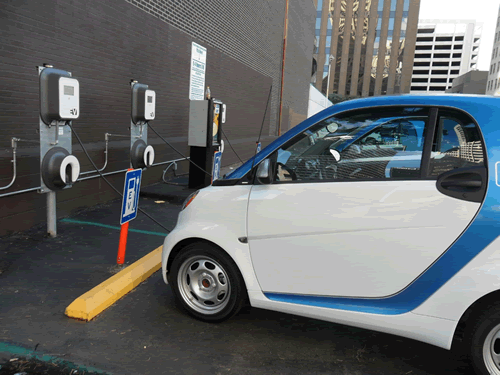Connectors Play a Key Role in Charging Infrastructure
The next few years will bring an increasing number of electric cars onto the roads. But not everyone can charge at home.

As the topic of environmental sustainability becomes more important, electric vehicles are growing in popularity.
The next few years will bring an increasing number of electric cars onto the roads. But not everyone can charge at home. How are connector companies helping to develop the charging infrastructure needed to support this transition? We asked Marc-André Beck, Market Manager at HUBER+SUHNER, and Lorenzo Bonadeo, Market Director Transportation at ITT Cannon, for their insights on EV charging products and infrastructure.
Connector Supplier: What products has your company developed for EV charging infrastructure?
Marc-André Beck: HUBER+SUHNER has developed a cooled cable charging system consisting of a cooled CCS-1 and CCS-2 connector, a cooled cable according to international and US requirements, and a cooling unit in conjunction with suppliers to dissipate the heat took out of the cable.
Lorenzo Bonadeo: ITT has been offering EV charging solutions for about a decade, beginning with AC charging systems and moving into the DC high power charging solutions we offer today. We have recently introduced a new high-power system with 1,000-volt charging capabilities. This system is based on a liquid-cooled cable and connector, integrated with a specific cooling unit, and can operate at up to 500 A, supporting both CCS-1 and CCS-2 interfaces. It will mainly be used in charging corridors along motorways but can also be deployed in commercial settings. It will allow charging of EVs to an additional range of 100 km (60 miles) within three to five minutes.
Connector Supplier: What unique requirements and challenges guided the development of these products?
Marc-André Beck: Never before has a user without special training held a connector and cable operating at 400kW in his or her hand. Safety was our foremost design goal. Also, the product needs to be at least as convenient to use as a gasoline pump. Our design goals were to create a highly flexible, lightweight, and thin cable. We also wanted a slick connector design that could fit in big or small hands and reduce the moment of force on the wrist.
Lorenzo Bonadeo: Based on various customer requests raised since 2015, we launched our high-power charging solution development around several core requirements, such as safeguarding uncompromised product safety, optimizing heat dissipation within its components, allowing reliable operation in all climate zones. Another priority was to offer a prime end-user experience with a light/flexible cable, and to minimize life-cycle costs to support charging station manufacturers and operators. Other goals were reducing thermal and mechanical stress along the contacts, providing easy installation and in-field service capability, and protecting the environment, through a non-conductive and environmentally friendly cooling medium.
Marc-André Beck: Broad knowledge was brought in from the railway industry, where HUBER+SUHNER is the market leader with jumper cables between the wagons. A lot of movement on the cable requires a good design for strain-relief and torsion resistance. Also, design specifics were brought in from the radio frequency and fiber optics division.
We have over a century of history in the connector industry, and we serve many markets, including military and aerospace, transportation (heavy and off-road vehicles, railways), industrial, medical equipment, and oil & gas. Our experience in all these industries served as the foundation for the knowledge we brought into the EV market.
Connector Supplier: What other applications and experiences prepared your designers for this specific challenge?
Marc-André Beck: Broad knowledge was brought in from the railway industry, where HUBER+SUHNER is the market leader with jumper cables between the wagons. A lot of movement on the cable requires a good design for a strain-relief and torsion resistance. Also, design specifics were brought in from the radio frequency and fiber optics division.
Connector Supplier: How are you partnering with the auto industry to develop charging infrastructure?
Marc-André Beck: HUBER+SUHNER is partnering with the automotive industry in co-development of the relevant new standards, and closely collaborating with the automotive industry to help deploy the HPC-stations in a very short time. Still, our main customers remain the manufacturers of charging stations. Also, HUBER+SUHNER is not partnering with any government and hasn’t received any subsidies from governments.
Lorenzo Bonadeo: Right now, the industry still needs to develop the final standards. The market demand is moving faster than the standards, so it’s very important to fulfill it, but, at the same time, build a system of standards and ensure interoperability going forward. ITT participates in standardization committees and industry initiatives such as CharIN, to promote the adoption of the Combined Charging System (CCS) as the global standard for charging battery-powered electric vehicles, and to develop a certification system for use by manufacturers. Europe is leading the way in this effort, but North America is coming along quickly.
Connector Supplier: This is a rapidly evolving sector. What issues do you expect to encounter in the future as these stations proliferate?
Marc-André Beck: HUBER+SUHNER is very confident about the reliability of the technology we are using. Maybe the biggest challenge will be the evolving standards, as almost none of the required ones are approved. Also, future governmental requirements could slow down deployment.
Lorenzo Bonadeo: We are ready for tomorrow, having anticipated the availability of next- generation electric cars with high-performance batteries. The technology we are bringing to the market is the bedrock, and it’s future-proof for the coming years. We have very strong customization capabilities and our system components are far from their limitations and designed to fulfill even enhanced performance demand, i.e. on current rating or individual customization.
Recently posted:
[related_posts limit=”10″]
- Meet the Connector: DIN Standard Connectors - April 16, 2024
- Software-Driven Radio Reinvigorates Old Technology - April 9, 2024
- What is a Busbar? - April 2, 2024






